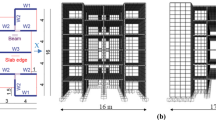Abstract
The seismic vulnerability of masonry aggregates is assessed with an approach based on the discrete element method. In that purpose, a quasi-static push-over procedure has been developed, in which a load pattern, based on the building first mode of vibration, is applied to the studied structure. Using this approach, the magnitude of the horizontal load to be applied for the building to collapse is obtained after a short computation time, as well as a detailed description of the failure mechanism. These results can be useful, for instance, for identifying the weakness of a structure or for comparing quantitatively the vulnerability of different structures. The beneficial and negative effects on the seismic response of the aggregation are assessed by subjecting isolated and aggregated buildings to both in-plane and transverse loads. As observed by engineers during post-seismic field missions, the buildings at the extremities of the aggregate are more prone to damage, because, contrary to the buildings inside the aggregate, they are not efficiently braced by the neighboring structures.












Similar content being viewed by others
References
Alexandris A, Protopapa E, Psycharis I (2004) Collapse mechanisms of masonry buildings derived by the distinct element method. In: Proceedings of the 13th world conference on earthquake engineering
Azevedo JO, Sincraian G, Lemos JV (2000) Seismic behavior of blocky masonry structures. Earthq Spectra 16(2):337–365
Benedetti D, Carydis P, Pezzoli P (1998) Shaking table tests on 24 simple masonry buildings. Earthq Eng Struct Dyn 27(1):67–90
Calderini C, Cattari S, Lagomarsino S, Rossi M (2010) Review of existing models for global response and local mechanisms. PERPETUATE Eur Res FP7 D7:1–64
Cundall PA (1971) A computer model for simulating progressive, large scale movements in blocky rock systems. In: Proceedings of the international symposium on rock fractures. Nancy, France II-8, pp 1–12
D’Ayala DF (2005) Force and displacement based vulnerability assessment for traditional buildings. Bull Earthq Eng 3(3):235–265
D’Ayala D, Speranza E (2002) An integrated procedure for the assessment of seismic vulnerability of historic buildings. disp 3(1):3–3
Da Porto F, Munari M, Prota A, Modena C (2013) Analysis and repair of clustered buildings: case study of a block in the historic city centre of L’Aquila (Central Italy). Constr Build Mater 38:1221–1237
D’Ayala D, Speranza E (2003) Definition of collapse mechanisms and seismic vulnerability of historic masonry buildings. Earthq Spectra 19(3):479–509
Dubois F, Jean M (2003) LMGC90 une plateforme de développement dédiée à la modélisation des problèmes d’interaction. In: Actes du sixieme colloque national en calcul des structures, vol 1, pp 111–118
Galasco A, Lagomarsino S, Penna A, Cattari S (2002) TREMURI program: seismic analyser of 3D masonry buildings. University of Genoa
Gehl P, Seyedi DM, Douglas J (2013a) Vector-valued fragility functions for seismic risk evaluation. Bull Earthq Eng 11(2):365–384. doi:10.1007/s10518-012-9402-7
Gehl P, Douglas J, Seyedi D (2013b) Influence of the number of dynamic analyses on the accuracy of structural response estimates. Earthq Spectra. doi:10.1193/102912EQS320M
Giambanco G, Rizzo S, Spallino R (2001) Numerical analysis of masonry structures via interface models. Comput Methods Appl Mech Eng 190(49):6493–6511
Hart R, Cundall PA, Lemos J (1988) Formulation of a three-dimensional distinct element model—part II. Mechanical calculations for motion and interaction of a system composed of many polyhedral blocks. Int J Rock Mech Mining Sci Geomech Abstr 25(3):117–125
Jean M (1999) The non-smooth contact dynamics method. Comput Methods Appl Mech Eng 177(3):235–257
Lancioni G, Lenci S, Piattoni Q, Quagliarini E (2013) Dynamics and failure mechanisms of ancient masonry churches subjected to seismic actions by using the NSCD method: the case of the medieval church of S. Maria in Portuno. Eng Struct 56:1527–1546
Lemos JV (1995) Assessment of the ultimate load of a masonry arch using discrete elements. In: Middleton J, Pande GN (eds) Computer methods in structural masonry – 3, Books and Journals International, Swansea, UK
Lemos JV (2001) Modelling the behaviour of a stone masonry arch structure under cyclic loads. Comput Methods Struct Mason 5:101–108
Lemos JV (2007) Discrete element modeling of masonry structures. Int J Archit Herit 1(2):190–213
Lourenço PB (2002) Computations on historic masonry structures. Progress Struct Eng Mater 4(3):301–319
Rafiee A, Vinches M, Bohatier C (2008) Modelling and analysis of the Nîmes arena and the Arles aqueduct subjected to a seismic loading, using the Non-Smooth Contact Dynamics method. Eng Struct 30(12):3457–3467
Ramos LF, Lourenço PB (2004) Modeling and vulnerability of historical city centers in seismic areas: a case study in Lisbon. Eng Struct 26(9):1295–1310
Rossetto T, Alexander D, Verrucci E, Ioannou I, Borg RC, Melo J, Cahill B, Kongar I (2012) The 20th May 2012 Emilia Romagna Earthquake, EPICentre Field Observation Report
Tomazevic M (2000) Some aspects of experimental testing of seismic behavior of masonry walls and models of masonry buildings. J Earthq Technol 37(4):101–117
Tomaževič M, Weiss P (2010) Displacement capacity of masonry buildings as a basis for the assessment of behavior factor: an experimental study. Bull Earthq Eng 8(6):1267–1294
Visseq V, Alart P, Dureisseix D (2013) High performance computing of discrete nonsmooth contact dynamics with domain decomposition. Int J Numer Methods Eng 96(9):584–598
Yi T, Moon FL, Leon RT, Kahn LF (2006) Lateral load tests on a two-story unreinforced masonry building. J Struct Eng 132(5):643–652
Acknowledgments
The results have been achieved in the project PERPETUATE (www.perpetuate.eu), funded by the European Commission in the Seventh Framework Programme (FP7/2007-2013), under Grant Agreement No. 244229. We thank John Douglas for proof-reading this article. We thank the anonymous reviewers for their comments on an earlier version of this article.
Author information
Authors and Affiliations
Corresponding author
Rights and permissions
About this article
Cite this article
Ulrich, T., Negulescu, C. & Ducellier, A. Using the discrete element method to assess the seismic vulnerability of aggregated masonry buildings. Bull Earthquake Eng 13, 3135–3150 (2015). https://doi.org/10.1007/s10518-015-9754-x
Received:
Accepted:
Published:
Issue Date:
DOI: https://doi.org/10.1007/s10518-015-9754-x




